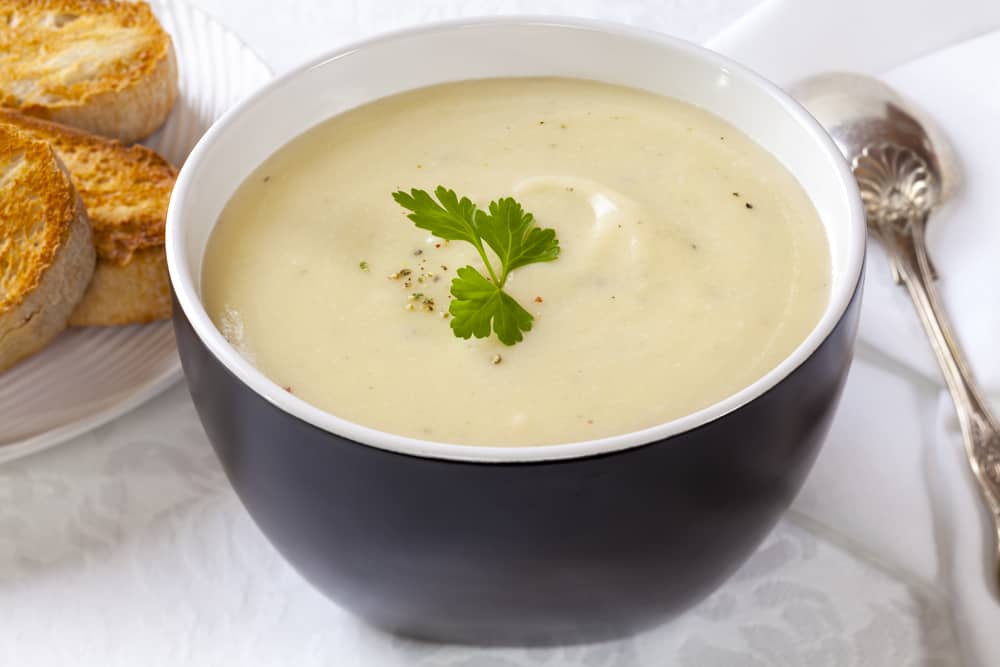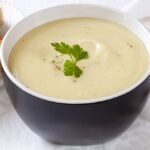Last Updated on 17th July 2023 by
Potato soup is probably my favourite soup, and that’s mostly because of how many tasty things you can put in it and still call it potato soup. I like to throw tons of cheese in mine, as well as mushrooms, garlic, and onions. Then, I top it off with chives, parsley, or bacon bits.
Making potato soup is kind of like making a pizza, to my mind. You can just keep adding more stuff to it, and it just keeps on getting better. Thick, creamy potato soup is the ultimate comfort food that you don’t have to feel too guilty about eating.
It’s filling, so you don’t have to eat a lot of it to feel satisfied. Plus, it has potatoes in it, which are a vegetable, and you can add more vegetables as well to make it even more nutritious.
I like my potato soup to be thick and when it is too thin, it tastes too much like vegetable soup to me. It’s not as comforting and as pleasant to my belly when it is thin.
The thick creaminess of traditional potato soup is so pleasant, and there will be times where I mess up the recipe slightly and need to thicken the soup. I think this happens to everyone who isn’t a baking expert.
How to thicken potato soup? I have a few methods I use, and I will use a different one for specific reasons. So, I will tell you how to thicken up potato soup and why you should use one method over another in each case.
Table of Contents
How to Thicken Potato Soup with Flour
I think most people will default to flour when thickening potato soup. It’s simple enough and they may be used to thickening other foods with flour as well. It makes sense to use flour to thicken up pancake batter or cornbread batter, for instance, because there is already a lot of flour in there. If the batter looks too thin, you just add some more flour to give it the right consistency.
However, flour is my least recommended way to thicken up potato soup. The reason for that is because flour is pretty flavourless. It detracts from the flavour of the soup, making it thicker, sure, but also less tasty.
Then, you have to add more salt or other seasonings to compensate, and that can turn a healthy potato soup into an unhealthy one. Flour works as a thickener for potato soup, but it’s not what I prefer to use.
Anyway, how to thicken potato soup with flour? I’m assuming your problem is that you need to thicken the soup after it has been completed. So, you already have your potatoes and other ingredients in there and are looking at a completed but thin soup.
When adding flour, be sure to only add a little at a time. It is very easy to overdo it and add more than you need, making your soup too thick and draining it of flavour.
To prevent clumps from forming and to avoid having unmixed flour in your soup, mix your flour in a separate bowl from the pot of soup. Don’t mix it directly into the soup at first.
Instead, mix it with a little water or butter (for extra flavour) in its own bowl. Once it is thoroughly mixed and you have gotten out all the clumps, you can add it to the pot of soup.
If you are making a large pot of soup, you can add about three tablespoons of flour at a time. For a small pot, mix in about one tablespoon of flour at a time.
To make the soup more flavourful after adding in the flour, you can add more salt, a flavour cube or melted butter.
Easy Recipe For Potato Soup
Easy Recipe for Potato Soup
Ingredients
- 8-10 medium size russet potatoes, peeled and cut into 3/4 inch cubes
- 1 medium onion, diced
- water to cover
- 1/4 cup butter or margarine
- 4 cups milk
- 2 cups heavy cream
- 1 Tbsp salt
- 1/2 tsp black pepper
- 1-2 cups mashed potato flakes , to thicken
Instructions
- Add potatoes and onions to a stock pot. Cover with water to slightly above the top of the vegetables.
- Bring to a boil. Reduce heat to medium and simmer until potatoes and onions are tender, about 20-30 minutes.
- Add butter or margarine.
- Slowly add milk, stirring constantly. If you add the milk too quickly, it could curdle and cause little milk lumps in the soup. This won’t affect the flavor, but it doesn’t look particularly appetizing.
- Add cream to soup once milk has been fully incorporated.
- Season to taste with salt and pepper. I like my soup relatively salty, but I added enough to flavor the soup while still leaving room for people to add more if they wish.
- Finally, stir in potato flakes a handful at a time, waiting a minute or so between handfuls to be sure you don’t over-thicken the soup. Once the soup is as thick as you like it, you don’t need to add any more potato flakes. If you happen to over-thicken, just add a bit more milk.
Notes
How to Use Potato Starch to Thicken Soup
A kitchen ingredient I have started using a bit recently after newly discovering it is potato starch. It is a great thickener and adds more flavour than you get with something like cornflour.
If you want to know how to thicken potato soup without flour, then potato starch is one of the better options. It’s already ground up for you and works as a great thickener, keeping that authentic potato soup flavour by using potatoes to thicken. That’s why it is my favourite way to thicken up the potato soup. It’s just sensible.
Like the flour, I suggest mixing this starch separately in a bowl. You want to mix it with a little water. You are making it into a slurry, which is a thick and creamy texture, and you will use one cup of water to five tablespoons of potato starch.
As with the flour, only use a small amount at a time, thickening slowly to see if it thickens enough before adding more. It is difficult to correct the issue once you make the soup too thick. If that happens, you have to try to course correct by adding more liquid, which can turn into an awful back and forth fight between making it too thick and too thin.
All the time you will be trying to fight to keep the flavour intact as well, and you don’t want all that hassle and headache, so take it slow and add in only a little at a time.
How to Thicken Up Potato Soup with Potatoes
The old fashioned way to thicken potato soup that a lot of chefs prefer is to use regular potatoes. You used potatoes to make this soup, so why not use potatoes to make it even thicker?
The way to do this and thicken potato soup using potatoes is to make some of your potatoes into mashed potatoes. There are a couple ways to do this.
One way is to take some of the potatoes from the soup and pull them out, mash them up or put them in a blender and create mashed potatoes from those. That way, you are not adding more potatoes to the soup, so you are keeping your ingredient proportions the same.
Another advantage to this method is that you have already cooked potatoes you are using, so the prep time is kept low and you don’t have to boil new potatoes. It’s quick and easy to make mashed potatoes from those.
The second method is to use new potatoes and cook them and mash them up, just like you would make mashed potatoes. Of course, it takes longer but you don’t have to use up the potatoes in the soup to do this method.
If you are perfectly happy with the amount of potato chunks in your soup as it is, then I would suggest using this method. Just be sure to cream the potatoes well, using milk, salt, and butter to keep them flavourful. To keep it creamy, add as much milk as is necessary and puree the potatoes well. Keep in mind that the more milk you add, the thinner the soup will be.
How to Make Potato Soup Thick with Cornflour
One other method I would mention is using cornflour. This is a pretty common ingredient to use for thickening just about anything. You only need a small amount to thicken just about any food, which is why it is so useful and so widely used.
It is very important that you mix the cornflour ahead of time in a separate bowl before pouring it into the soup. You also only want to use a very small amount, because it won’t thicken right away but will thicken a lot in a matter of minutes.
You may not feel like you used enough at first, when you mix the cornflour into the potato soup, but as it thickens over time, you will see just how effective it is.
So, put a little cornflour into a small bowl and use just enough water to be able to mix it into a slurry. That means it is thinner than a paste but not very watery. Whisk together the water and cornflour quickly and thoroughly. Make sure you dissolve all of the flour-y particles.
If you wait too long to mix too slowly, the cornflour will become lumpy and hard to work with. If you end up making it lumpy, it is better to just start over with the cornflour than try to use it in its lumpy form.
Cornflour can be a tricky substance to work with as a thickener, so use it gradually and sparingly. It’s okay if you don’t get it right the first time, and while many cooks prefer cornflour for all of their thickening needs, I understand that it may not be ideal for new or inexperienced cooks. That I why I have left it at the bottom of this list of potato soup thickeners.
Now you have a few different ways to thicken potato soup. I gave you multiple ways because some of them are easier than others and some of them may involve ingredients that you have on hand.
You can choose one or another based on how much concern you have over the flavour of the soup, what you prefer to use and what you have available to you.
Keep in mind that thin potato soup can be fixed with a number of methods, and you don’t have to feel down about too thin potato soup. It can be fixed with one of these proven methods.
How to Make Potato Soup
This easy recipe for potato soup is quick and simple, and it only costs a few bucks to make a huge pot of soup. It even tastes better as leftovers! If you want a recipe for truly rich and creamy potato soup, this is the one.
This is basically my grandmother’s recipe for potato soup, except I’ve made a few minor modifications. First, I add a “not-so-secret” secret ingredient to thicken the soup without having to fool around with making a roux. Second, I’ve added some heavy cream to make the soup a little more rich. (Granny just used milk, which made the soup a bit watery for my taste.)
This soup is absolutely delicious as-is, but you can also add in a few other ingredients to turn it into a loaded baked potato soup, too. Just add some sour cream, green onions, bacon and shredded cheddar cheese at the table. (Everyone can customise their soup to their liking.)
FAQs
Are there any differences in taste or texture between the three methods of thickening potato soup?
Yes, different thickening methods can lead to slight differences in taste and texture. For example, if you use a roux (a mixture of fat and flour) to thicken your soup, it may impart a slightly rich and creamy texture with a mild nutty flavor. If you’re using puréed potatoes, the soup will have a more consistent potato flavor throughout and a naturally creamy texture. Lastly, using a cornstarch slurry will thicken the soup without significantly altering the flavor, but it can create a slightly glossy appearance and a different mouthfeel.
Can I use a combination of these methods to thicken my potato soup?
Yes, you can use a combination of these methods, but it’s important to do so thoughtfully to avoid altering the flavor or texture too much. For example, you might purée a portion of the potatoes for a consistent flavor and then add a cornstarch slurry to further adjust the thickness to your liking.
What are some common mistakes to avoid when trying to thicken potato soup?
One common mistake is adding too much thickening agent at once, whether it’s flour, cornstarch, or puréed potatoes. It’s better to add a little at a time and let the soup simmer for a few minutes to reach its full thickness before deciding if you need more. If you’re using a roux or a slurry, make sure to cook it long enough to get rid of the raw flour or cornstarch flavor. Finally, remember to stir continuously while adding your thickener to prevent lumps from forming.
I'm Pauline, a mother of four grown children, my passion for cooking stemmed from the joy i get cooking for my family. I love to try new dishes, especially when dining out but creating and sharing my own recipes is my favourite thing to do!




impressibilities
Friday 21st of February 2025
vDLO96x1cCJ
Theresa
Wednesday 20th of March 2024
I'm diabetic and looking how to lessen the carb intake of potato soup without losing the flavor and texture